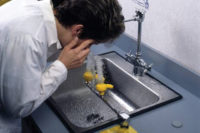Confined space case files
3 tales teach lifesaving lessons








1) A dangerous assumption
During a Middletown, Ohio, incident in May of 2010, three firefighters were injured, including a veteran fire marshal and captain, responding to an emergency call for a downed utility worker. Upon arrival, the firefighters gazed into a deep manhole inside a city sanitary sewer line, and found the broken body of a city worker lying at the bottom. They assumed that the worker had simply fallen into the 30-foot-deep service access, miscalculating the fall to be the mechanism of injury. They attempted to make contact with the downed worker — who failed to respond — then made the decision to move in. Based upon the distance of the fall, they decided that a body recovery was in order, so an entry team descended by rope into the dark vertical space. As a result of their misunderstanding the incident, they neglected to test the air (pre-entry) or even to don protective respiratory equipment (SCBA). The post-incident investigation would prove that the utility worker fainted immediately as he removed the inspection cover, and fell in.
The victim was overcome by a powerful gust of low oxygen, later reported to be only two percent. Normal atmospheric oxygen levels are about 21 percent. The fire department recovery plan that day included physical entry via rope access, to package and transport the victim to the surface. The firemen made an unprotected entry into the space and entered an untested, immediately dangerous to life and health (IDLH) environment. Once in the space, they all fell unconscious and had to be rescued by other firefighters. If the emergency response team had followed established protocol — to always test air in a confined space — they would have been able to protect themselves and prevent additional injury.
2) Specialized safety training
Asphyxiation hazards account for the majority of documented fatalities in confined spaces. A NIOSH study of OSHA cases from 1984 to 1986 indicates: “Out of 188 deaths, 146 were from oxygen deficiency or poisoning by gases or chemicals in confined spaces.” The ongoing effort to protect workers in confined spaces from toxic vapors, low or high oxygen levels is more than just an important consideration; it is our duty to protect. We need to ensure that workers are properly trained to work in confined spaces, and especially to use and calibrate gas detection instruments. Design trainings to include gas detection principles and emergency response. This is clearly more than just handing workers an instrument and ordering them to evacuate if they hear the alarm go off. But unfortunately, some managers have the attitude of fake-it-until-you-make-it for the newly elected confined space attendant. They often neglect to design or implement a first class training program. Since each confined space location can present a unique and special set of hazards, gas detection responsibilities must be given to someone who is mature, trained and accountable to his/her team.
A confined space attendant should receive additional training by expert instructors. I have seen many construction companies send a worker through basic training then assign them as acting confined space attendant. A recent training trend centers on online confined space training. On a recent client hospital project, one of our team members conducted daily inspections of subcontractor work including painters, electricians, welders and pipefitters. When we asked them to verify their confined space training, they sent us copies of an online course; a very weak 40-minute event. I immediately voiced objection, but the project manager was quick to say he had authorization for their training — unbelievable but true.
On today’s modern construction project, safety seems to be under attack and being squeezed hard for every competing dollar. Not all companies operate this way but keep an eye out for this type of behavior and do what you have to, even do the class yourself.
From that point on, we had nothing but trouble with these guys; never could get through a single day without them breaking numerous OSHA regulations. Most of the issues centered around their choice of confined space attendants; this group definitely needs specialized safety training. There are both state and federal OSHA mandates that specify responsibilities for attendants in the confined space regulations; find them online at www.osha.gov.
3) Air testing: tubing matters
Another frequently misunderstood issue concerns air testing (via direct read instrument) in remote locations: manholes, tank vehicles, aircraft wing tanks, fuel vessels, holding or storage reservoirs, underground facilities, interstitial spaces, ceilings, etc. When remote sampling is employed, the most frequently recommended extension tubing (non-absorbing) for gas detection is: Tygon®, Teflon® or metal tubing. There is good reason to ensure that non-absorbing tubing is used, as exemplified in the following story.
A few years ago, we had a client that had a bunker waterproofing project at a hospital, adjacent to the surgery wing. We were told they would be working in a confined space located at the bottom of a parking structure, on the project. Since it had been some time since we had seen one of their projects, we decided to pay them a visit and conduct a safety inspection. Once we located their position in the parking structure, we were able to see the telltale tripod, and we found their confined space attendant taking air samples from the entry portal. They had 20 waterproofers in the hole (work zone) using rollers to apply a high VOC (volatile organic compound) sealant or waterproofing agent. They were applying the material with rollers onto the sides, ceiling and floor of a huge concrete holding tank (newly built) for the hospital surgery center. We became concerned when we smelled the powerful odor of solvents emanating from the space, and we noticed they were using a length of 1/8-in. i.d. vinyl tubing connected to the air testing monitor (sniffer). Normally, remote air testing is done with special Tygon or Teflon tubing, but construction companies have been known to cut corners by using a cheaper alternative.
We decided to check out their instrument and found the LEL sensor reading zero (on the instrument). Since we had a gas detector with us, we decided to cross check and verify instruments. We donned a respirator, fired up one of our sniffers, and carried it into the space; one change, we did not attach any tubing to the unit. As we made entry into the space, we had instant confirmation of our worst expectations; the LEL sensor on our unit went off instantly and into full alarm mode (lights and alarm). Naturally, we called for an immediate evacuation of the space and were able to get the entire team of workers out of the space without incident.
At this point, the team and attendant wanted to know why we shut them down, especially considering that their attendant’s sniffer indicated a zero LEL read. We calmed them down and showed them our unit; we conducted a brief safety time out, and reviewed all the data. First, we took their sniffer, removed the hose and sent the unit in on a rope; they were very surprised to see their unit go off, just like ours did, as it entered the solvent-enriched atmosphere. Then we took our sniffer, connected their hose and, sure enough, a zero read on the LEL. After running this comparative a few times, they finally got the idea that something mysterious was happening. We told them it wasn’t the sensors or detector; it was an issue due to the tubing they were using.
We changed out the length of their tubing for a clean length of Tygon®, placing the sampling end (suck) again into the space. Naturally, they were surprised to see that the read was the same as when we used no tubing at all. We had to help them understand why there was such a disparity between one tubing type and the other; they did not understand the physics at work. We explained that cheaper tubing and especially vinyl plays a nasty trick when trying to obtain an accurate reading of the atmosphere. The solvent vapor stream is actually sucked into or absorbed by the sidewall of porous tubing. So on its way to the LEL sensor, the gas vapors (solvent fumes) are completely absorbed and never make it to the sensor, resulting in a false negative response at the display. This was a valuable lesson learned, especially for the confined space attendant.
Golden Rule: Never substitute the manufacturer’s recommended sample tubing for a lesser quality alternative. Although you may save a few dollars, it may be your ultimate confined space.
Sources
Baker J., Morse J., May 7, 2010 (Cincinnati.com), “City worker killed, three firefighters hospitalized in Middletown,” jbaker@enquirer.com, jmorse@enquirer.com
Rekus, J, 1994, Complete Confined Spaces Handbook, pgs. 28,29.
National Institute for Occupational Safety and Health (NIOSH), January 1994, “Worker Deaths in Confined Spaces” online http://www.cdc.gov/niosh/docs/94-103/pdfs/94-103.pdf, Summary of NIOSH Surveillance & Investigative Findings.
Federal OSHA, 1910,146(i), Permit Confined Space Standard, Duties of Attendants Online version http://www.osha.gov/pls/oshaweb/owadisp.show_document?p_table=standards&p_id=9797
Cal/OSHA, Subchapter 7, General Industry Safety Orders, Group 16. Control of Hazardous Substances Article 108, §5157, Permit Confined Space Standard, Duties of Attendants Online version http://www.dir.ca.gov/title8/5157.html
Looking for a reprint of this article?
From high-res PDFs to custom plaques, order your copy today!








